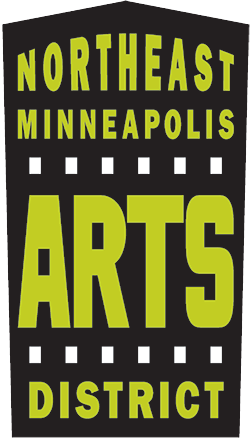“The Print Club” is what Ingrid Restemayer has taken to calling a core group of Northrup King Building (NKB) artists who recently have begun to meet to share their work and information about printmaking. “It’s a way that we can collaborate and show together and start to create a little more energy or synergy,” said Dean Trisko, who organized the group and in whose studio the group’s first exhibition was presented.
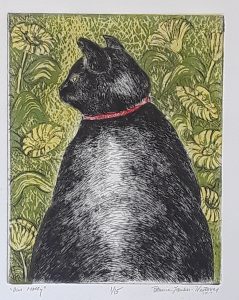
“NKB Prints: a group printmaking show” included the work of 11 artists and was open to the public Thursday, Jan. 6, and Saturday, Jan. 8, with some of the artists holding open studios those days. Trisko explained that all the prints in the show were “hand-pulled,” meaning that they’re original works, designed and printed by the artists by hand, with limited or single editions.
Viewing the exhibition and visiting with the artists in their studios was like taking a course in printmaking, reports Karen Kraco who wrote this article. It gives a window into the many ways artists creatively incorporate prints into their work in other mediums.
Relief printing
Solvei Stohl concentrated on photography in art school and beyond, but in recent years she’s had an urge to make art with her hands. Inspired by Instagram posts by California artist Lili Arnold, Stohl ventured into printmaking three years ago, sometimes using her photos as the basis for the images she prints.
Stohl’s “Evening Buds,” a high-contrast, colorful print depicting tulips from her garden, is a linocut, a type of relief print. A relief print is made using a raised surface, onto which ink is applied and pressed onto a medium, such as paper or fabric.
For this print, Stohl hand-carved five blocks of linoleum (thus, “linocut”) and used them in seven separate printings for the individual color layers, first inking the blocks with a roller called a brayer, and then pressing the paper onto the block with a wooden spoon and a baren – a disk-shaped surface with a handle. A handmade frame with guides allowed her to position each of the five blocks – the positioning is called the “registration” – to align them perfectly to create the image from multiple plates.
Another relief print in the show, Dawn Wing’s “Breathe,” was inspired by a moth that landed on her front door. It incorporates a poem of Wing’s that was chosen for St. Paul’s sidewalk poetry series: “Breathe in, I’m here; Breathe out, I belong.” Wing, who concentrated on photography as an art student at Wellesley College, and also makes comics and zines, had been given linocut tools by a friend, but it wasn’t until she learned about the printing block material Soft Kut through a workshop at Minnesota Center for Book Arts that printing took off for her. She likes Soft Kut for its ease of carving and affordability; she also works with Akua soy-based inks for their texture, transparency, and colors.
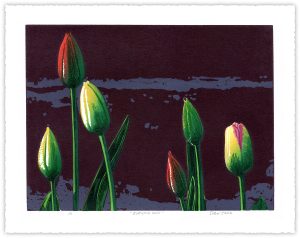
Intaglio printing
On the fourth floor, Ingrid Restemayer demonstrated intaglio (in-tahl-ee-oh) printing, a process that is basically the reverse of relief printing. Intaglio prints are made with etched plates, with the ink in the etched grooves of the plate pressed onto the paper by being pulled under a large roller.
The plates can be copper or zinc, and etched with acid; or plexiglass or other plastics, scratched with sharp tools, a process called “drypoint.” Restemayer explained that plates can be used for many impressions: zinc up to 500 times, copper about 100, and many fewer times for the plastics, until the grooves etched in the plate start breaking down.
Restemayer has used many different types of plates for different projects, but for some of her small prints she uses recycled Best Buy gift cards (her day job is in marketing for the company), scratching designs into them with etching needles and dental tools. Once the etching is complete, she loads a thick ink, “almost like axle grease,” onto the plate and spreads it into the grooves. She covers the whole plate with ink, then carefully wipes away the excess ink on the surface with a paper towel, folding it to a point to get into the small areas of the design. All the ink that remains is in the etching.
The plate is then placed on a backing mat on the bed of her intaglio press. The paper she will print on is prepared by soaking it in water. “Having it be wet helps it fall into those little spaces,” she explains. Then she puts the paper over the plate and covers it with a protective sheet and a blanket. Then the blanket, plate and paper are rolled under a large-diameter roller.

Depending on the project, the first couple print runs might be proofs, followed by adjustments made in the etching. The gift card plates are good for only a handful of passes before they start to break down, Restemayer explained. After they’re done giving crisp images, she runs them through on handmade papers for a less defined effect.
Intaglio variations
In Restemayer’s series of works she calls “scrolls,” she combines her prints of animals and rows of running stitches and French knots on hand-dyed paper. Other artists in the show also incorporate intaglio printing into collage and multimedia treatments.
The intaglio prints that second-floor artist Beth Dorsey used in her piece “Deconstructed Windows,” were made with a polymer photogravure plate which is light sensitive and can be used to make impressions of digital images. Dorsey used such a plate to print multiple prints of a photo of a window, some on different colors of Asian paper. The final work is composed of the prints arranged in different orientations in a grid.
Gwen Partin, who has a fourth-floor studio, incorporates monotype prints in collages. (Monotype prints are unique prints, rather than one of a run.) Much of Partin’s work is heavily patterned and textured; some of her printing involves collagraph printing, in which textured substances are used as plates. She has woven a grid of paper strips and coated them with a polymer, then used it as a plate; she also has used paper stencils both as printing plates and also as overlays or underlays in collages, even using a stencil in both ways for the same piece.
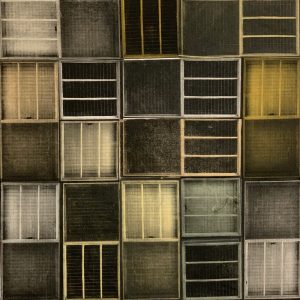
Sometimes artists will paint or draw on a print. Dean Trisko’s “Intersection” is a print made from a plastic plate etching depicting the train bridge at 18th Avenue and Monroe Street NE. The print is highly textured with lines and cross hatching used to convey the different elements of the composition. Trisko added watercolor on top of the print.
Trisko, who has been in the Northrup King Building since 2001, said some people think of him mainly as a painter, but he’s made prints since his 20s, he said. “It’s not uncommon for something that I do in print to then work into types of painting or vice versa.”
He said he has a free-form approach to printmaking, using prints as the jumping-off point for creating. Most of his prints are one-offs or very small editions, he said. “I’m not about making massive numbers. It’s more of a creative approach.” He’s printed photos of his collages; embedded bits of colored paper into the printing process (a technique called chine collé), and has used, with his community college students, Xeroxed transparencies with photosensitive plates.
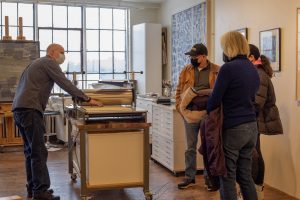
Trisko retired in August from teaching art at Minneapolis Community and Technical College, and the 24” x 48” intaglio printer that sits in his studio is a retirement gift to himself. “My joy comes from making. I love to just, you know, make this bigger, make that darker, make that brighter. … And once that starts, that’s the excitement for me.”
Other NKB printmakers in the exhibition were Lynn Bollman, Kathleen Malecki, Chris Nystrom, and Patty Scott.
Reported by Karen Kraco, published in the Northeaster newspaper Feb. 2, 2022, used with permission. People photos by Karen Kraco, other images courtesy of the artists.
